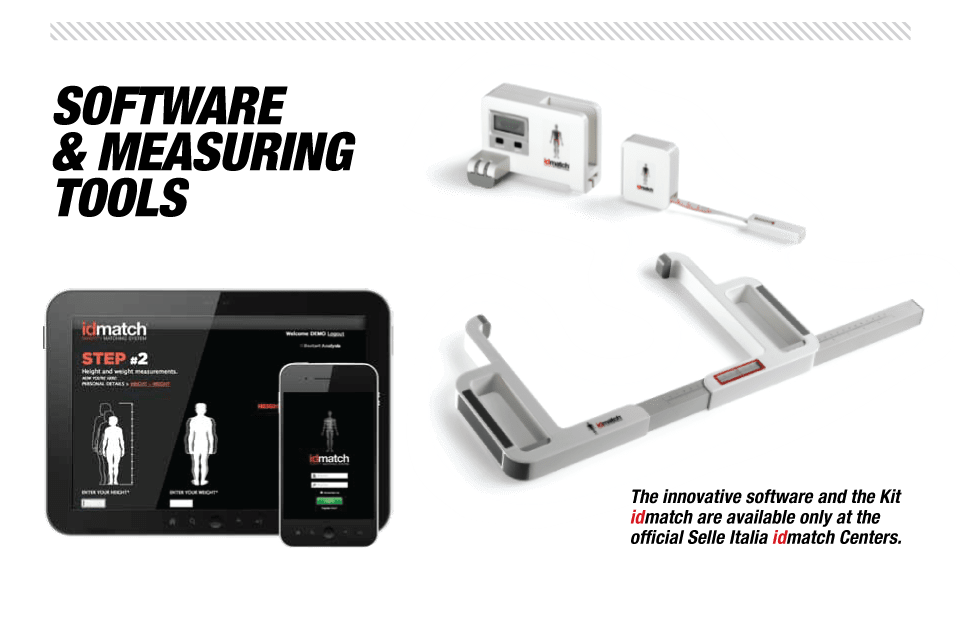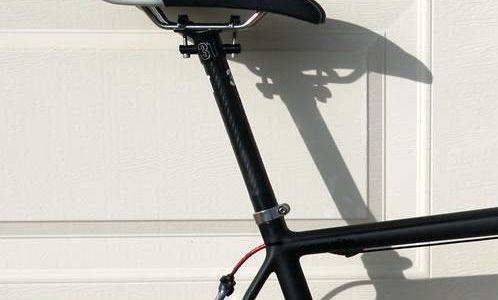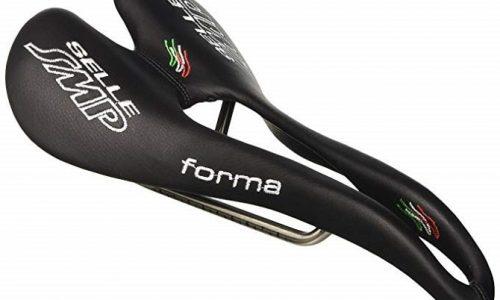SELLE ITALIA has a process called idmatch. You get professionally fit with a 4-step system where they measure
- General parameters – age, height, weight, gender, type of cycling
- Intertrochanteric distance

- Thigh circumference
- Pelvic rotation/flexibility
Numbers 2 above is used to determine the width of the saddle, while number 4 is used to determine what part of your anatomy comes into contact with the saddle. Funny thing is that even though they measure thigh circumference, they never use it in the calculation, or in the design of the saddle. I will even offer that they need a #5 – Qfactor to complete a move accurate fitment, but more on this later.
An example of why #4 is so important is that a cyclist who rides in an aero position could have very little flexibility in their pelvis, which means that 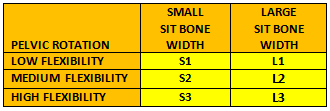 even in an aero position, their pelvis is coming in contact with the saddle as if sitting totally upright. In this example, their spine is doing all of the bending. While, at the other end of the spectrum, a cyclist with a high degree of flexibility will have their hips rotated naturally forward, placing all of their weight on their soft tissue… even while riding in a more upright position. In this latter example, this person
even in an aero position, their pelvis is coming in contact with the saddle as if sitting totally upright. In this example, their spine is doing all of the bending. While, at the other end of the spectrum, a cyclist with a high degree of flexibility will have their hips rotated naturally forward, placing all of their weight on their soft tissue… even while riding in a more upright position. In this latter example, this person 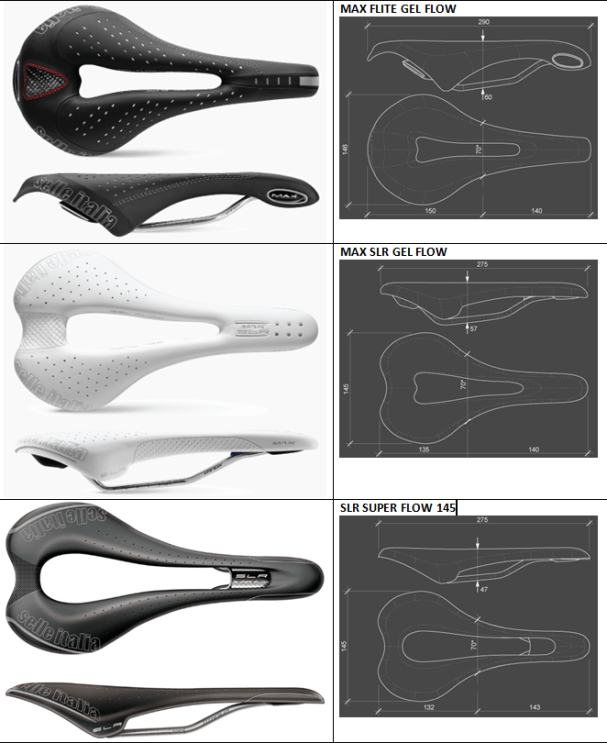 will need a saddle with a wider and longer cutout. The results of #2 and #3 will place the cyclist into either an “S” small category, or “L” large category. The result of #4 will give the cyclist a rating of 1 (low degree of flexibility/pelvic rotation), 2 (medium degree of flexibility/pelvic rotation) or 3 (high degree of flexibility/pelvic rotation). You then use this classification as you look for saddles through their website. My results were L3 and the reason I chose the SLR Superflow to test.
will need a saddle with a wider and longer cutout. The results of #2 and #3 will place the cyclist into either an “S” small category, or “L” large category. The result of #4 will give the cyclist a rating of 1 (low degree of flexibility/pelvic rotation), 2 (medium degree of flexibility/pelvic rotation) or 3 (high degree of flexibility/pelvic rotation). You then use this classification as you look for saddles through their website. My results were L3 and the reason I chose the SLR Superflow to test.
Even though this analysis fits you into a definite category, this does not take into account people with medium width (M width since the table only accounts for Small & Large widths) sit bones. In order to accommodate this (i.e., provide more comfort), anyone can use a different classification as seen in the table.
HOW TO SET UP THE SELLE ITALIA SADDLE
This saddle is very close in dimensions to the Specialized Romin, I started with the same setup measurements. Since the Selle Italia SLR has a slightly lower profile, I set the saddle height 2mm higher than the Specialized. Everything else was the same. I set the rails parallel to the ground so that the nose was tipped slightly downward. To get ready for a 50 miler the next day, I test rode the bike around the block a couple times to check the setup, it felt good.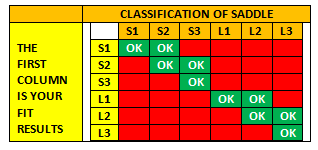
Except for the ISM ADAMO, the Selle Italia is the flattest of all saddles tested. Except for a very small arch towards the rear of the saddle, it is dead flat. The Selle Italia has a 2.38mm (3/32”) tall rise at the rear where the Specialized has a 7.14mm (9/32”) rise at the rear. Flat saddles are for those that like to move around vs, a saddle that has more contour is for someone that wants to stay put.
HOW DOES IT RIDE?
My 50 mile ride today was 50% tough hills, 50% fast, flat, level group ride.
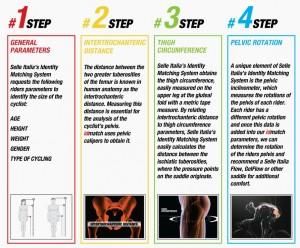
In the hills, I felt strong so I pushed a good cadence. It was easy to move around on the saddle, but, because I am not used to riding a ‘flat’ saddle, I felt I was moving around a little more than with the Selle SMP or Specialized. Not a ding on the saddle, just my physiology and riding style – I like to sit and push back during climbing. For effective hill climbing, this saddle relies on a larger-width profile so that the back of the legs are used to push back into the saddle. Since I have always used saddles with a lip at the rear, using the legs to push back against the saddle vs pushing your rear end into the saddle is a different riding style for me.
I couldn’t quite get used to this different required style, but that’s just me. For someone that normally rides a flat saddle, this would be an ideal saddle for them. There are also two very subtle contours on the top of the saddle that I call divits. These are small indentations for your sit bones.
They are wide and subtle enough where you can still move around without them interfering. I like this design feature since it makes it more comfortable and you can always find your home position.
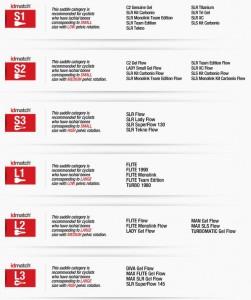
“idmatch will not just offer one saddle recommendation, but a recommendation within a category of saddles with several models to choose from.
Category S: This idmatch category is for cyclists who have a SMALL distance between their ischial bones.
Category L: This idmatch category is for cyclists who have a LARGE distance between theiir ischial bones
Each size is further subdivided in 1, 2, aand 3 according to the pelvic rotation of the cyclist (1/low, 2/medium, 3/high).”
Since there is very little padding support on this saddle, Selle Italia has added an elastomer piece directly under the front SLR Logo. This is where the front of the titanium rails lay on and is enough to deaden the road shock that would get transmitted through a hard and rigid saddle. This too is another great idea that works since the foam padding is fairly thin and very firm. Not quite as firm as the Selle SMP Dynamic, but firmer than the Specialized. The foam on the SLR (guessing 6mm) is a little thicker than the Dynamics (5mm), but not as thick as the Specialized (guessing 7mm). This elastomer really does help to absorb road shock..
With its Carbon fiber shell, the saddle is very firm, even with Titanium rails. A high quality leather cover completes the package. This is a very high quality saddle that rides very sturdy and very well.
WHERE I FELT PRESSURE AND WHERE I DIDN’T
What I noticed was that this saddle seemed to ride wider than the others. 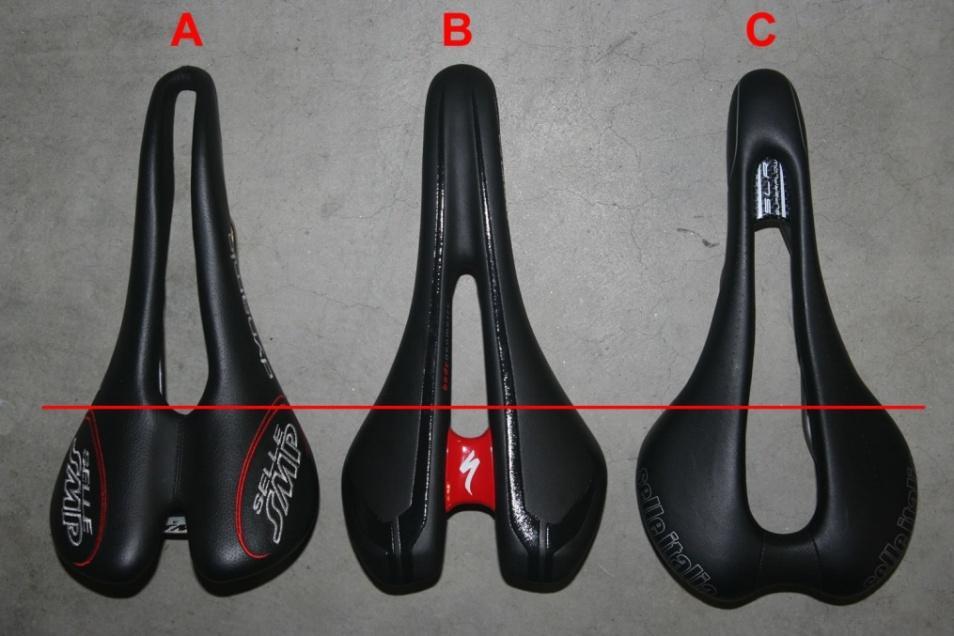 The horizontal red line indicates where your hamstrings are coming into contact with the saddle when pushing back climbing. A=Selle SMP, B=Specialized Romin, C=SelleItalia SLR. Even though the widths of B, C are almost identical, the SLR starts it’s arch sooner than the others thereby making it feel wider, wide enough for me that it didn’t feel right. But again, someone with thinner thighs would be fine with this saddle.
The horizontal red line indicates where your hamstrings are coming into contact with the saddle when pushing back climbing. A=Selle SMP, B=Specialized Romin, C=SelleItalia SLR. Even though the widths of B, C are almost identical, the SLR starts it’s arch sooner than the others thereby making it feel wider, wide enough for me that it didn’t feel right. But again, someone with thinner thighs would be fine with this saddle.
The second design issue can be seen in the SLR’s profile where there is a ‘tab’ that protrudes sharply down. This seemed to poke me in the back of the legs with every pedal stroke. It appeared to me that this was done by a designer for logo placement vs. any utility achieved from this tab.
 I offer feedback to Selle Italia that if they take a look at these two items, they would have a much more comfortable and perfect saddle.
I offer feedback to Selle Italia that if they take a look at these two items, they would have a much more comfortable and perfect saddle.
- A little less taper to the side flare. More in line with A, B.
- Nix the tab (profile) and bring the edge of the saddle back maintaining its current arc
HITS:
| MISSES:
|
| SUMMARY: Again, this is my analysis based on my physiology. In my opinion, this saddle could be the ultimate saddle but a couple of design issues stop it short. | |
| RATING: 3.75/5 | |
Next time: Saddles Part 6: So Who Won?

I have always enjoyed bicycling and, through a series of coincidences, became a Bicycle Industry Consultant and Product Tester. I test prototype products for companies and have published only off the shelf production products on biketestreviews.com.

